Art History Flashcards
1/29
Earn XP
Description and Tags
These flashcards cover key terms and definitions relevant to art history, focusing on important sculptures, frescoes, and architectural styles from various periods.
Name | Mastery | Learn | Test | Matching | Spaced |
|---|
No study sessions yet.
30 Terms
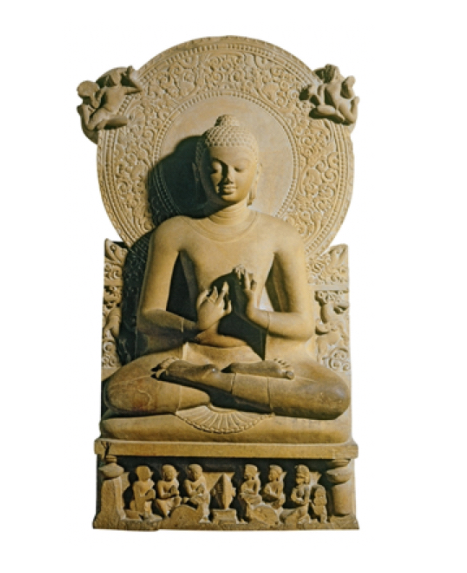
The Buddha preaching the first sermon
Sarnath, India. Gupta period, made of Sandstone.
Gupta artists adopted aspects of Kushan-era images, combining new elements.
Notable for its triangular composition with Buddha at the center.
His legs are crossed and his hands are in a teaching mudra referencing Sarnath as the location of his first teaching sermon.
It has the standard iconography: the ushnisha and elongated earlobes.
There is a carved round halo and rectangular base.
There is a sense of stability and stillness.
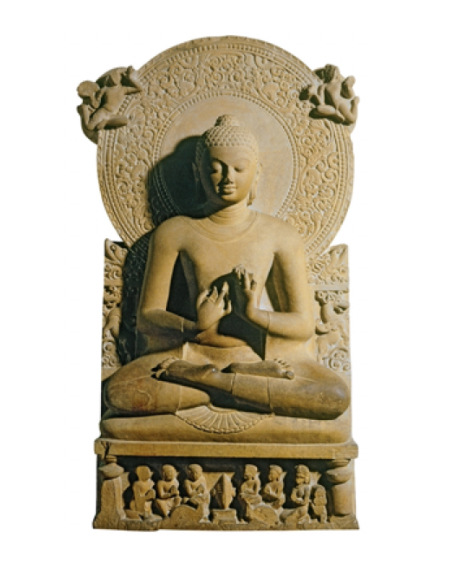

the Orator
Etruscan, from Lake Trasimeno, Italy , made of Bronze
depicting an Etruscan man in a Roman toga, showcasing realism (verism) in his features and naturalistic stance.
Was created using a lost-wax casting technique.
Once had inlaid eyes.
He has wrinkles on his forehead and neck.
His name is etched in the hem of the toga. Depicted in a naturalistic contrapposto stance.
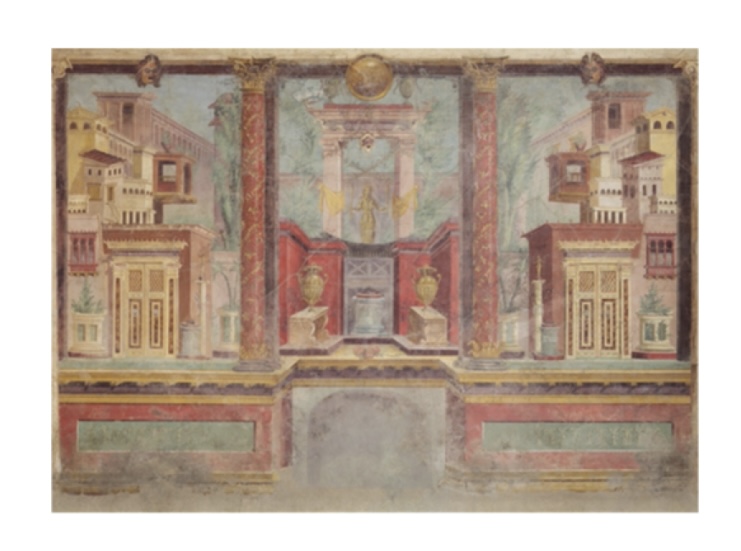
Bedroom with wall paintings, House of Publius Fannius Synistor
Boscoreale, near Pompeii, Italy, mid-first century bce Republic
Its covering an entire bedroom in a villa at Boscoreale, near Pompeii.
It showcases illusionistic architectural elements and spaces.
painted columns with realistic shadows and imaginary scenes of buildings of the outside world
The visual explosion of the flat picture plane is accomplished through the use of linear perspective.
The technique was probably used earlier in Greece as well but was later rediscovered in the Renaissance.
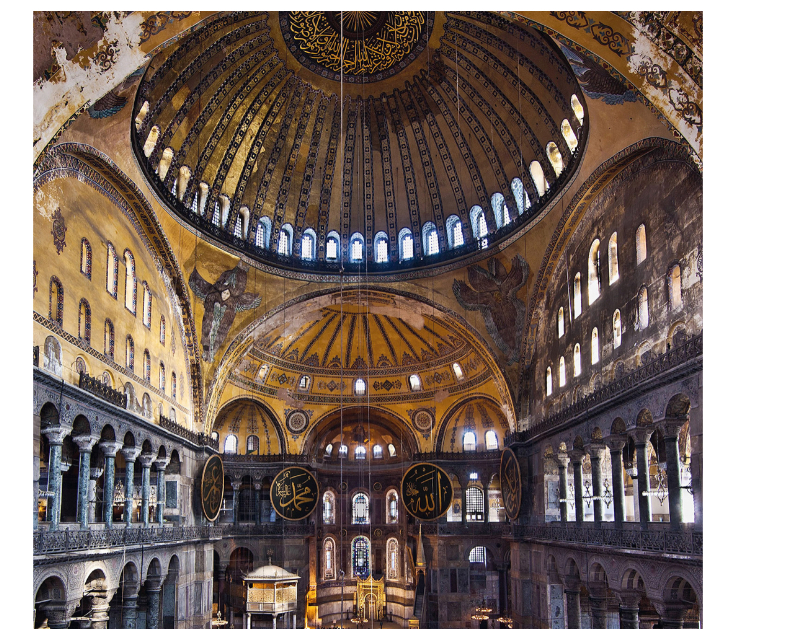
Hagia Sophia
in Constantinople, built in Byzantine, made of marble and mosaic
A cathedral
Famous for its large dome supported by stone piers and thin brick enclosing walls that allow light to filter through the pendatives.
It features marble and mosaics, as well as intricately carved stone capitals and arches.
The name translates to 'Holy Wisdom'.

Interior of the Pantheon
Rome, Republic, made of marble and concrete
A temple
a perfect sphere would fit an oculus
is colored marble
has a drain for rainwater
commissioned by Marcus Agrippa
the expansive interior nods to Hadrian’s appreciation for Classical Greek architecture with combining advanced concrete engineering.
Its name derives from 'pan' (every) and 'theos' (god)
traditionally seen as a temple for all Roman gods, with some evidence linking it to the divine authority of the emperors.
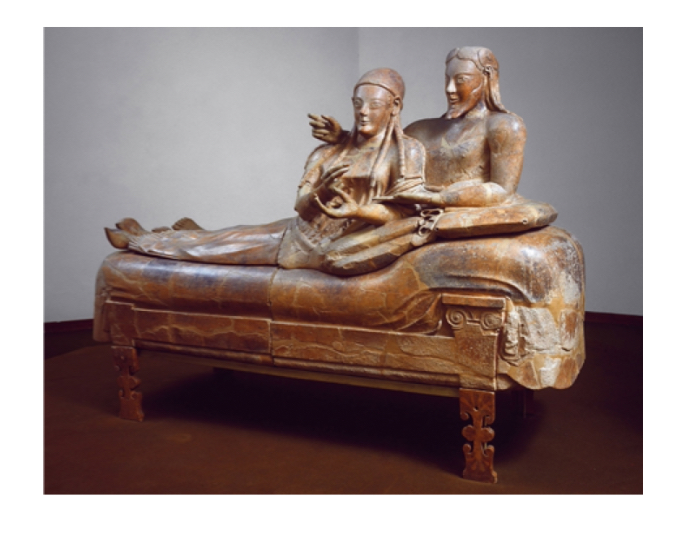
Sarcophagus of the Spouses
Etruscan, terra-cotta, from the Banditaccia necropolis, Cerveteri, Italy
burial urn, maybe a cremation urn because of the time
depicting a couple reclining together presumably at a banquet
reflects women's elevated status in Etruscan society.
symbolizing the equality and companionship in Etruscan culture
Terra-cotta was probably burnished (rubbed to achieve a glossy sheen).
it was cut in half and then fired in pieces To fit the work in the kiln
Its size and quality point to the wealth and high status of the couple represented.
This dining tradition was common in Etruria.
Gestures convey affection and the bond of marriage.
His right hand may have held a drinking vessel or an egg: a symbol of fertility and rebirth.
Wife may be pouring scented oil or perfume from a small container called an alabastron
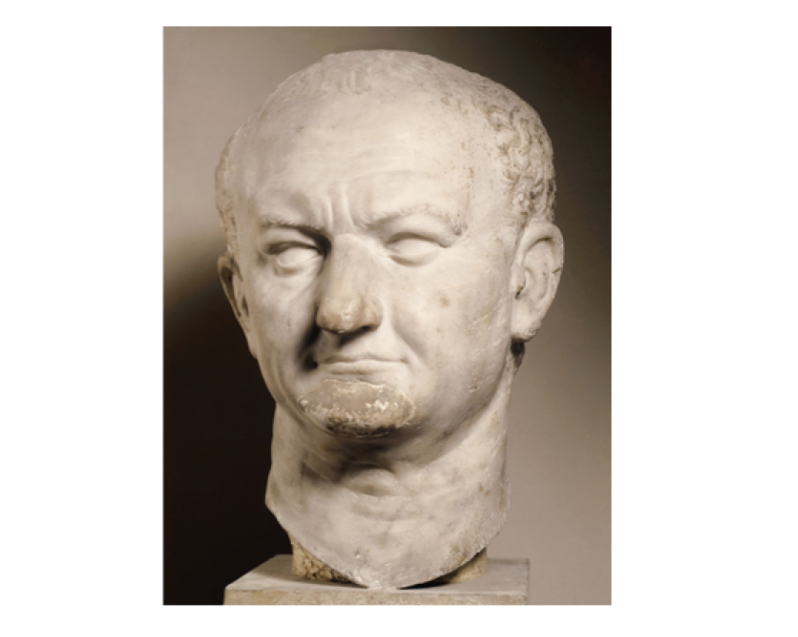
Portrait of Vespasian
Ostia, Italy, Early Empire, Marble.
characterized by veristic features emphasizing age and wisdom.
The emperor is shown with a receding hairline, wrinkles on the face and neck, and pursed lips.
The portrait looks back to the traditional portraiture style of the Republic.
Probably helped legitimize his rule because his people felt alienated after Nero.
The artist successfully showed a concerned emperor with keeping the empire rich and stable.
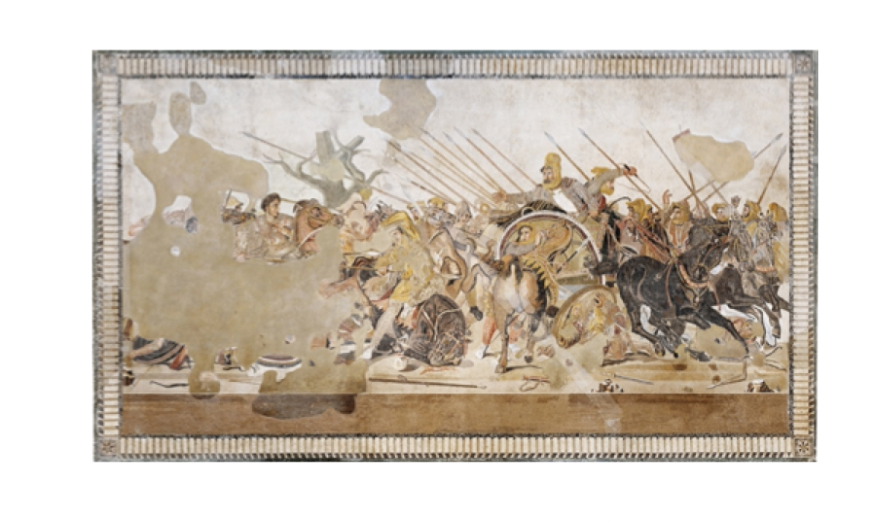
Alexander Mosaic
Pompeii, Italy, Republic
A mosaic depicting the Battle of Issus, by Philoxenos of Eretria
showcasing the transition from painting to mosaic art in ancient Rome.
This remarkable piece illustrates the military clash between Alexander the Great and Darius III.
The mosaic captures movement and emotion,
demonstrating the use of perspective and color
Many scholars believe that the Alexander Mosaic may be a Roman copy of that lost painting
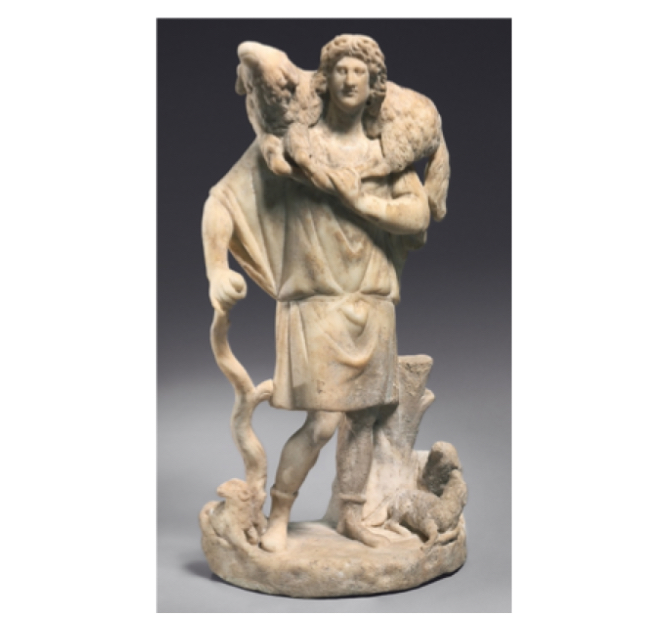
Good Shepherd statue
Anatolia (likely), mid 300s CE, marble
An early Christian marble statue reflecting youth and idealism, inspired by classical imagery of Apollo.
he does not have a beard and is more youthful looking and has defined biceps.
They still made their own iconography and religious images to generate stories.
this depiction of Christ was uncommon in sculpture before the Edict of Milan.
portable Early Christian statues like this one were commissioned by wealthy patrons
Law Stele of Hammurabi
Babylonian BUT excavated at Susa, made of Black basalt.
An ancient inscribed black basalt stele featuring laws of Babylon, with relief of Hammurabi receiving authority from the sun god Shamash.
The top portion is carved with a relief showing the encounter between Hammurabi and the sun god Shamash, who presents Hammurabi with a rod and ring, symbols of royal power.
It is one of the oldest surviving legal records, providing insights into the social hierarchy of Mesopotamian society.
It is carved from black basalt and polished to a high sheen, featuring horizontal bands of cuneiform inscribed with laws.
The laws are inscribed in horizontal bands in cuneiform using the Akkadian language.
The text reflects the social ranking of Mesopotamian society, which included land-owning free men of the upper class, commoners, free people of the lower class, and slaves.
It was originally installed in Babylon, but it was excavated at Susa, in present-day Iran.
Bust of Nefertiti
from Akhetaten (Tell el-Amarna, Egypt), Eighteenth Dynasty, Painted limestone with gypsum plaster layers
found in a sculptor Thutmose studio, perhaps a reference or sort of sketch as it was found with many other half finished and finished sculptures.
depicts a more realistic while still idolized version of nefertiti with a very long neck and very symmetrical face.
Peplos Kore
Athens, Archaic period . Marble with traces of original paint
named for the peplos it is thought to be wearing
it turns out that Peplos Kore is wearing more than just a Peplos, instead many separate clothing items worn together.
The Votive was buried on the Arkopolis.
This suggests that the statue is an early depiction of Artimites.
the broken left arm may have once held the bow of Artimis.
Nike Adjusting Her Sandal
parapet, Temple of Athena Nike, Athens, Classical period, Marble
This finely carved figure is eroticized
the diaphanous, wet-looking drapery slips from one shoulder while clinging tightly to other parts of Nike’s body.
Nike is removing her sandal because she is approaching sacred ground.
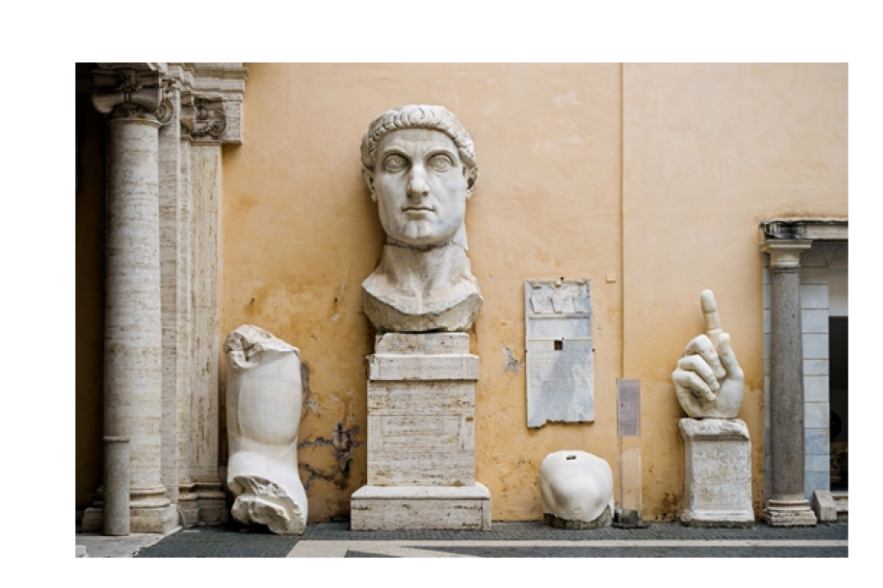
Fragments of colossal seated statue of Constantine
Basilica Nova, Rome, made of Marble, from Late Empire
Portrait propaganda.
intended to awe the viewer and to make a powerful statement of the emperor’s virtual presence.
This sculpture represents a powerful individual ruler with aspirations toward global dominion.
It had a head and limbs of marble, some of which remains, and perhaps a body of brick and wood covered in gilded bronze.
Constantine embraced a more Classical style for this portrait.
His hairstyle is clearly modeled on Trajan’s: Roman bowl-cut.
Portrait features are present but idealized: youthful, clean-shaven, as in earlier statues of Augustus.
He has a strong jawline; a Roman aquiline nose, and deep drilled pupils.
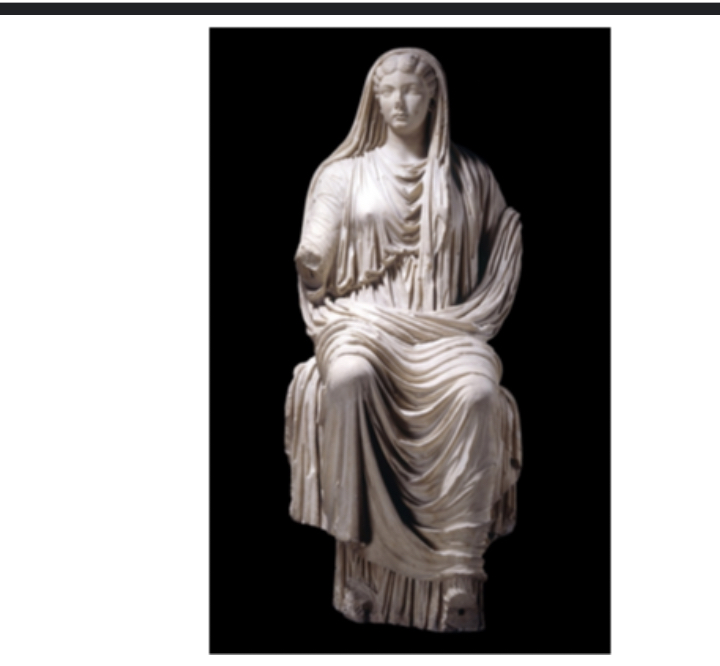
Statue of Livia
From Paestum, Italy, Early empire
Was the third wife of Augustus and first empress of Rome
crucial part in his political, social, and religious rule.
Livia used portraiture to convey her rank and status.
Sculptures of her were common throughout the empire
Possibly had portrait prototypes for her statues because they were all very consistent with depicting her
modelled on high classical Greek art
Statue presents her as youthful and idealized for Roman women to look up to.
Livia is shown modestly draped in a mantle (cloak) and heavy tunic, with her head covered, indicating her piety.
There is evidence of attachments for a metal diadem on this sculpture.
Her large stature, with full hips and breasts, suggests her role as matron of the empire.
The statue is based on Greek-goddess types, specifically enthroned figures and the reliefs of seated goddesses, such as Hera.
The consistency of her facial features with other portraits makes her instantly recognizable.
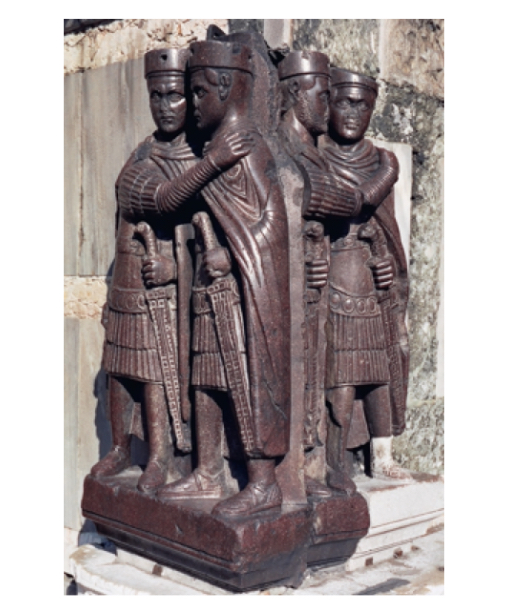
Portraits of the Tetrarchs
From Constantinople, Late Empire
Carved in porphyry Porphyry is a purple stone reserved for imperial families and the gods
Dioclaitin started the Tetrarchy as a solution to the instability of the 3rd secession of the 3rd century
Tetrarchy = 4 administrators
Two sculptures put together this statue
depicting an Augustus and a Caesar in a tight embrace
generality and abstraction replace individuality and naturalism
No distinctions between the rulers in terms of facial features, stature, dress, and gesture, with the exception of the beards worn by the Augusti: to show advanced age.
They wear the cuirass and cloak of the military general.
Each figure grasps the hilt of a jewel-inlaid, eagle-headed sword.
The emphasis here is the concordia, or harmony, of the tetrarchs at the expense of their individuality.
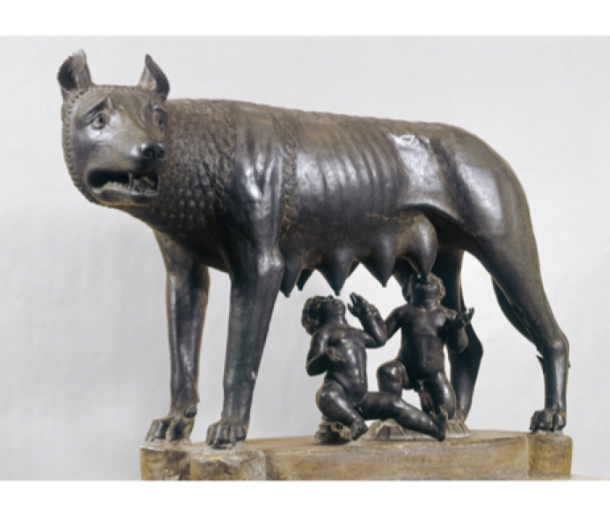
Capitoline Wolf
Rome, from Republic or medieval period, made of Bronze
Often associated with the tale of the she-wolf that suckled the legendary founders of Rome, Romulus and Remus, after they were thrown into the Tiber River as babies and left for dead.
When the sculpture was transferred to the Capitoline Hill to add the suckling figures, it was the site of ancient Roman government, thus connecting the sculpture to ancient Roman history.
They have been attributed to the sculptor Antonio Pollaiuolo.
The hollow bronze-casting technique suggests that the statue may be medieval rather than ancient.
This was cast as a single piece of hollow bronze, a technique more common to the Middle Ages.
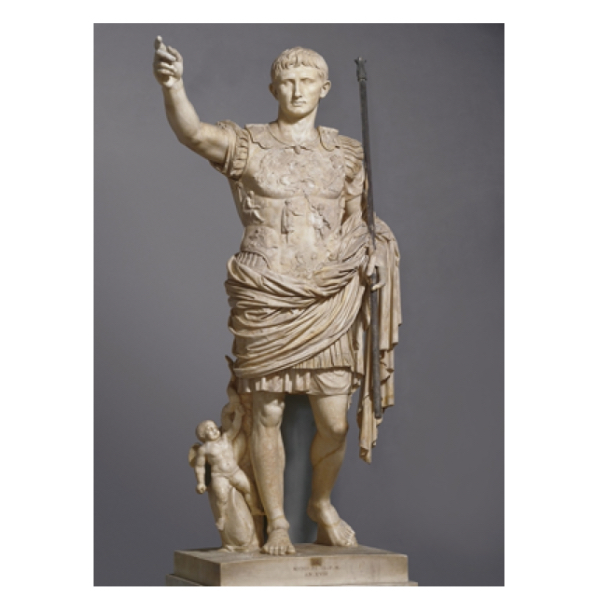
Augustus as imperator
Villa of Livia, Prima Porta, Italy, Early Empire - “Pax Romana” Marble, originally painted, maybe copy of OG bronze.
A marble statue representing Augustus in an idealized youthful form, embodying Roman ideals of leadership and divine status. Favoring contrapposto features, reminiscent of Polykleitos’s Doryphoros (Spear Bearer).
Augustus demanded a youthful appearance and robust physique, as he was never portrayed as elderly.
This statue may be a posthumous copy of an earlier bronze original, as evidenced by Augustus's bare feet resembling those of a god, a detail that implies the work was created after his deification in 14 CE.
No bronze original has been found.
Recognizable attributes such as his hairstyle and facial features suggest the use of an approved prototype by sculptors.
The left hand, which may have initially held a spear, is complemented by Cupid, the god of love and desire, who is seen holding onto Augustus's leg, symbolizing Venus, the goddess of love, from whom Augustus claims descent.
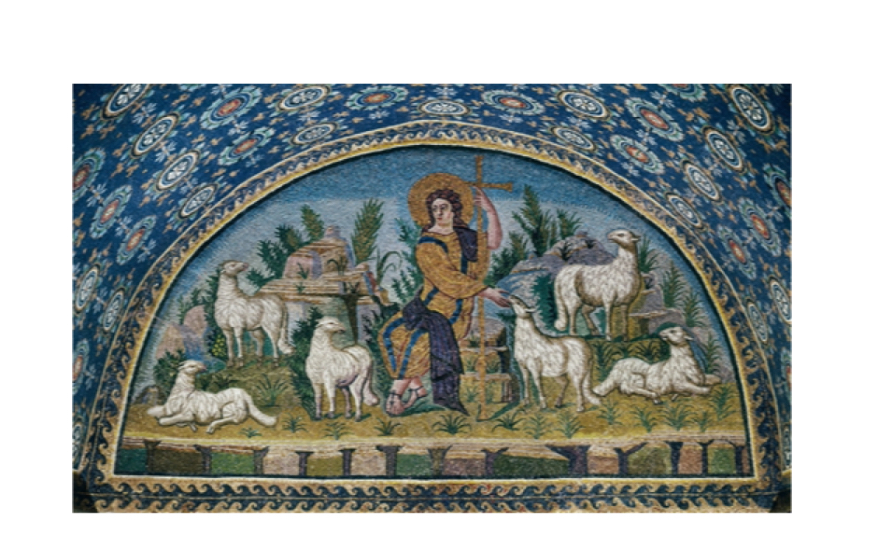
Good Shepherd Mosaic (Oratory of Galla Placidia)
apse mosaic of church of Santa Pudenziana, Rome, Late Antiquity
Sheep represent Jesus’s original followers
Iconography for later decisions of Jesus
Oratory, centrally planned unlike most churches
Christ is depicted royal-looking, wearing gold, much like a Roman senator
Does not look like a civilian
Elevated status
South Asian statuette
found in pompii but from south asia, made of ivory, Early Empire
implies global perspective and trading
clearly defined vulva
a base
made from ivory
evidence of foreign trade routes
small
naturalism
facial features are naturalistic but not individualized
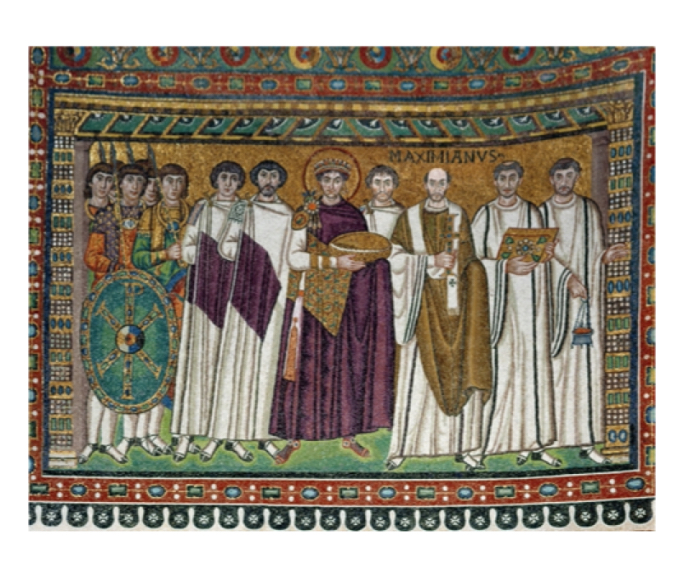
Justinian and his entourage
apse mosaic, north side, Church of San Vitale, Ravenna, Italy, from Byzantine era
The walls of the apse at the Church of San Vitale are covered with court portraits in mosaic.
The haloed and crowned Justinian, dressed in royal purple, stands in the middle of the north side mosaic.
holds a paten for the bread of the Eucharist
The emperor never entered this church but he is shown in the altar space bearing a gift: an expensive communion plate/paten
To his right stands his secular advisors and his army.
One of his soldiers holds a shield decorated with Constantine’s symbol of the Chi-Rho (the first letters of Christ’s name in Greek).
To the emperor’s right are clergymen & military to his left.
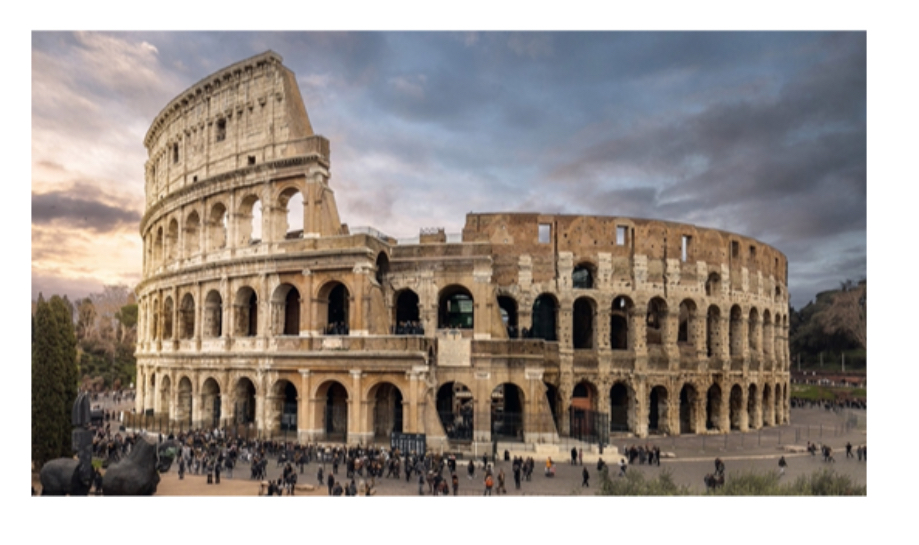
Exterior of the Colosseum (Flavian Amphitheater)
Rome, Early Empire, Tufa and concrete faced with travertine.
Flavian amphitheater, the largest amphitheater in the Roman Empire.
Name derives from its location near the Colossus of Nero.
Was an arena for gladiatorial games.
Was a huge oval arena of approximately 615 × 510 feet.
Its outer wall was 159 feet.
The building materials included an enormous concrete foundation, travertine (a light-colored limestone) piers, and concrete vaults.
Slanted vaults allowed for continuous rising seating with unobstructed views of the action below.Those of higher status seated closer to the arena floor.
A large awning (velarium) partially protected viewers from rain and the sun.
Under the arena rooms and hallways stored wild animals and gladiators who’d be ready to amerge to fight.
Narmer Palette
Predynastic, Dynasty 0, made of Graywacke
The Narmer Palette is named for the king Narmer, who is believed to have united Upper and Lower Egypt.
While palettes were commonly used for grinding minerals and preparing eye paint, the size of the Narmer Palette suggests it was likely used as a temple offering.
The palette features low relief and early hieroglyphics, with Narmer depicted at the center in hierarchical scale.
The palette includes two serpopards whose necks create a depression where khol would be put, and a falcon representing Horus, symbolizing defeat, violence, and power.
Stele of Akhenaten, Nefertiti, and children
from Akhenaten, Eighteenth dynasty, Limestone with painted sunken relief
The stele depicts Akhenaten, Nefertiti, and their three eldest daughters, showcasing a familial scene.
The figures are depicted in an endogenous style, with elongated proportions typical of the period.
The sun disk Aten symbolizes favor from the sun god, shining down on the family depicted in the stele.
There were radical changes in the visual culture of state religion during Akhenaten's reign, emphasizing humanity over traditional divine representations.
It was intended for a niche in a private home, as royal images were typically restricted to tombs and temples.
Seated statue of Gudea
Girsu (Tello, Iraq), Sumerian, made of Diorite
The statue represents Gudea, ruler of Lagash, dedicated to the god Ningishzida
diorite is known for its hardness and durability.
The stone’s hard surface is finely finished, well polished, and shiny, creating a dramatic sense of permanence.
The statue features an expressive body, attentive eyes, a clean-shaven face, and a cap, suggesting religious dedication.
The statue would have been placed in a temple
It is dedicated to Ningishzida, the god of vegetation and the underworld.
Army, tomb complex of the First Emperor of Qin
located in Lintong, Shaanxi province, China, Quin Dynasty
The Terracotta Army consists of life-size terracotta soldiers and horses created to accompany the First Emperor of Qin in the afterlife.
The army was intended to serve the First Emperor in the afterlife and demonstrate his military power, technology, and bureaucratic strength.
There are over seven thousand individually crafted figures in the Terracotta Army.
Many different craftsmen worked on the army, with numerous repeating signatures indicating a modular installation approach.
Snake goddess
found in the palace at Knossos, Crete
Minoan greek statue
Made of Faience
either goddess or a priestess
Owl on head references Athena or is Athena
Is a figurine believed to represent a ritual that may have been performed
found in a grave alongside frescos and broken pottery.
The skirts associated with the figurine reflect styles connected to West Asia, indicative of cultural exchange between the regions.
The snakes are thought to symbolize protection.
Exekias, amphora with Ajax and Achilles playing a board game
Athens, Archaic period
made of black figure ceramic
signed by the artist Exekias.
depicts the heroes Ajax and Achilles quietly playing a board game.
Ancient Greeks may have viewed it as ominous, foreshadowing the violent deaths of these two heroes
Polykleitos of Argos, Doryphoros (Spear Bearer)
located in Naples, Italy, High Classical period, Roman marble copy of Greek bronze
The sculpture likely depicts a male warrior, possibly Achilles.
The Doryphoros represents a youth in a naturalistic way, capturing details such as muscles and veins, but it is also idealized.
They favored more generic, youthful figures rather than specific individuals with portrait features.
They reflect Greek ideals of perfection and beauty
The Temple of Athena Parthenos AKA the Parthenon
akropolis, athens, from High Classical period
classical period
showcasing humanist ideals.
designed by the architects Iktinos and Kallikrates.
The columns of the Parthenon incline slightly inward, contributing to the building's dynamic appearance, avoiding any straight lines or perfect ninety-degree angles.
The Parthenon's design gives the viewer the impression that the building is rising dynamically, rather than appearing static or sagging, reflecting human-centered architectural principles.
The internal structure of the Parthenon exploded